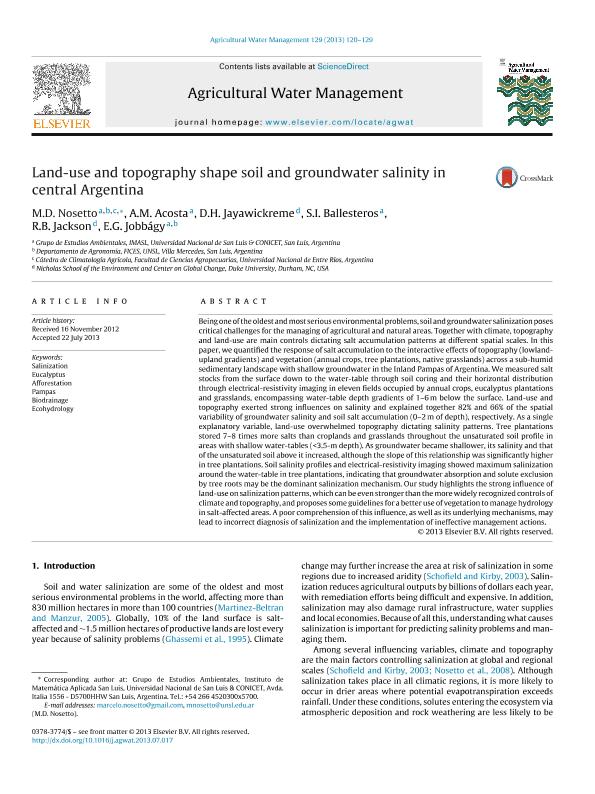Artículo
Land-use and topography shape soil and groundwater salinity in central Argentina
Nosetto, Marcelo Daniel ; Acosta, A. M.; Jayawickreme, D. H.; Ballesteros, Silvina
; Acosta, A. M.; Jayawickreme, D. H.; Ballesteros, Silvina ; Jackson, R. B.; Jobbagy Gampel, Esteban Gabriel
; Jackson, R. B.; Jobbagy Gampel, Esteban Gabriel
 ; Acosta, A. M.; Jayawickreme, D. H.; Ballesteros, Silvina
; Acosta, A. M.; Jayawickreme, D. H.; Ballesteros, Silvina ; Jackson, R. B.; Jobbagy Gampel, Esteban Gabriel
; Jackson, R. B.; Jobbagy Gampel, Esteban Gabriel
Fecha de publicación:
01/2013
Editorial:
Elsevier
Revista:
Agricultural Water Management
ISSN:
0378-3774
Idioma:
Inglés
Tipo de recurso:
Artículo publicado
Clasificación temática:
Resumen
Being one of the oldest and most serious environmental problems, soil and groundwater salinization poses critical challenges for the managing of agricultural and natural areas. Together with climate, topography and land-use are main controls dictating salt accumulation patterns at different spatial scales. In this paper, we quantified the response of salt accumulation to the interactive effects of topography (lowland-upland gradients) and vegetation (annual crops, tree plantations, native grasslands) across a sub-humid sedimentary landscape with shallow groundwater in the Inland Pampas of Argentina. We measured salt stocks from the surface down to the water table through soil coring and their horizontal distribution through electrical-resistivity imaging in eleven fields occupied by annual crops, eucalyptus plantations and grasslands encompassing groundwater depth gradients of 1 to 6 m below the surface. Land-use and topography exerted strong influences on salinity and explained together 82% and 66% of the spatial variability of groundwater salinity and soil salt accumulation (0-2 m of depth), respectively. As a single explanatory variable, land-use overwhelmed topography dictating salinity patterns. Tree plantations stored 7 to 8 times more salts than croplands and grasslands throughout the unsaturated soil profile in areas with shallow water-tables (<3.5-m depth). As groundwater became shallower, its salinity and that of the unsaturated soil above it increased, although the slope of this relationship was significantly higher in tree plantations. Soil salinity profiles and electrical-resistivity imaging showed maximum salinization around the water-table in tree plantations, indicating that groundwater absorption and solute exclusion by tree roots may be the dominant salinization mechanism. Our study highlights the strong influence of land-use on salinization patterns, which can be even stronger than the more widely recognized controls of climate and topography, and proposes some guidelines for a better use of vegetation to manage hydrology in salt-affected areas. A poor comprehension of this influence, as well as its underlying mechanisms, may lead to incorrect diagnosis of salinization and the implementation of ineffective management actions.
Palabras clave:
Salinizacion
,
Cambio en El Uso De La Tierra
,
Forestacion
,
Cultivo
Archivos asociados
Licencia
Identificadores
Colecciones
Articulos(CCT - SAN LUIS)
Articulos de CTRO.CIENTIFICO TECNOL.CONICET - SAN LUIS
Articulos de CTRO.CIENTIFICO TECNOL.CONICET - SAN LUIS
Articulos(IMASL)
Articulos de INST. DE MATEMATICA APLICADA DE SAN LUIS
Articulos de INST. DE MATEMATICA APLICADA DE SAN LUIS
Articulos(SEDE CENTRAL)
Articulos de SEDE CENTRAL
Articulos de SEDE CENTRAL
Citación
Nosetto, Marcelo Daniel; Acosta, A. M.; Jayawickreme, D. H.; Ballesteros, Silvina; Jackson, R. B.; et al.; Land-use and topography shape soil and groundwater salinity in central Argentina; Elsevier; Agricultural Water Management; 129; 1-2013; 120-129
Compartir
Altmétricas



